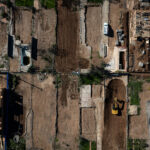A trio of third-quarter hurricanes and continued catastrophe losses impacting insurers and reinsurers will have a greater impact on reinsurers—and may potentially fuel reinsurance rate hikes at the Jan. 1, 2018 renewal date, S&P Global Ratings said Friday.
“Our current sentiment is for 0-5 percent of rate increase in global pricing at the upcoming Jan. 1 renewal,” the rating agency said in a report titled, “Third-Quarter 2017 Catastrophe Losses Are Becoming a Capital Event for Global Reinsurers,” referring to reinsurance pricing.
Prior to the recent catastrophic events, S&P expected a 0-5 percent reinsurance rate decline into 2018, the report noted.
“Each catastrophe event in and of itself is not sufficient to have made a significant impact on pricing, but the combined losses are a capital event for the reinsurance sector. Therefore, given the magnitude of the losses, we expect reinsurers to hold flat on pricing at the very least, but most will likely demand higher risk premiums at this time,” the report said.
The reinsurance report was one of two sector reports published by S&P Global late last week, after the ratings agency changed the outlooks on ratings for Lloyd’s and XL Group. In the separate announcements regarding Lloyd’s and XL, S&P noted that estimates of losses from hurricanes Harvey, Irma and Maria would likely move capital levels for the two organizations below levels consistent with their current ratings absent capital restoration actions.
In the other sector report—”U.S. P/C Insurance Ratings are Intact Following Hurricanes Harvey, Irma, and Maria, But the 2017 Atlantic Hurricane Season Continues,” published Thursday—S&P said the accumulated losses from the third-quarter hurricanes will have “material unfavorable effects on the earnings of U.S. P/C insurers”—potentially erasing two- or three-quarter of earnings but only representing about 3 percent of 2016 year-end capital.
For global reinsurers, on the other hand, S&P expects the third-quarter cat events will likely wipe out annual earnings and ultimately become a capital event for the sector.
S&P also commented on alternative capital. It “is implausible that such capital will entertain a similar price to that prior to the catastrophe events,” the reinsurance report said, suggesting that “an increase in rates in the alternative capital space is almost a given.” The price hike amount, however, “will depend on the supply-demand relationship and may take some time to play out.
“The price demanded will increase materially in our view, though the level of rate movement would ultimately be tempered by the amount of capital that can enter,” S&P said in the report, noting that the amount of new capital will also influence traditional reinsurance pricing.
The report pointed to possible “disarray” in the market for alternative capital, noting that capital deployed to exposed regions is locked in as collateral at this point. Funds are actively marketing for new capital to underwrite existing and potentially new business at the upcoming renewals, the report said.
Even though this year’s cat events could force “a rethink on the part of some third-party capital providers,” S&P believes sufficient capital is on the sidelines, waiting to enter the market.
Earlier in the report, S&P commented that only one rated catastrophe bond—Kilimanjaro Re 2-14-1 Class B—has been downgraded in the wake of Harvey, Irma and Maria, adding that the lack of downgrades isn’t surprising. “The per-occurrence bonds we rate generally provide protection for events viewed as occurring once in 50 years or less frequently,” S&P said, noting that Harvey and Maria aren’t falling into the 1-in-50-year grouping. Harvey was primarily a flood event and Maria did most of her damage in the Caribbean—putting them out of the scope of catastrophe bonds that are linked to insured industry losses. Flood, for the most part, is not a covered peril in the natural catastrophe space, and the Caribbean typically has a lower percentage of insurance coverage than either the U.S. or Europe, S&P explained.
“We think that the insurance industry and the natural catastrophe investor base have an opportunity to expand into these hitherto noninsured exposures and regions, and given the appropriate returns, can provide a new source of earnings for themselves and protection for many currently uninsured people and regions,” S&P said in the reinsurance report.
The report also includes charts illustrating the capital impact of a range of stress scenarios on the global reinsurance sector, and presents a list of 19 individual reinsurers in two groups—nine for which S&P believes total adjusted capital under the S&P capital will rise during 2017, and 10 where it will drop based on year-to-date catastrophe losses. Lloyd’s and XL fall in the latter group.





















 Insurance Costs, Climate Concerns Factor Heavily in U.S. Home Buying Decisions
Insurance Costs, Climate Concerns Factor Heavily in U.S. Home Buying Decisions  Homeowners Critical of FAIR Plan, State Farm A Year After LA Wildfires
Homeowners Critical of FAIR Plan, State Farm A Year After LA Wildfires  Good Times for U.S. P/C Insurers May Not Last; Auto Challenges Ahead
Good Times for U.S. P/C Insurers May Not Last; Auto Challenges Ahead  Underwriter, Actuary Fears of AI Drop; Work Needed on Collaboration
Underwriter, Actuary Fears of AI Drop; Work Needed on Collaboration 




